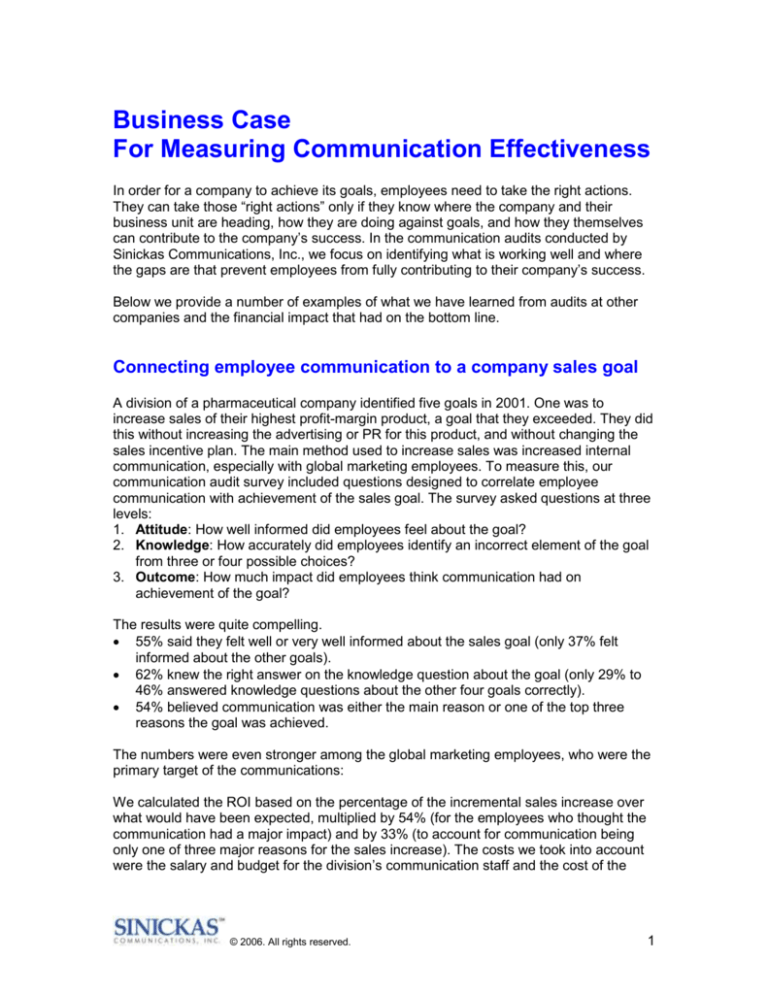
Business Case
For Measuring Communication Effectiveness
In order for a company to achieve its goals, employees need to take the right actions.
They can take those “right actions” only if they know where the company and their
business unit are heading, how they are doing against goals, and how they themselves
can contribute to the company’s success. In the communication audits conducted by
Sinickas Communications, Inc., we focus on identifying what is working well and where
the gaps are that prevent employees from fully contributing to their company’s success.
Below we provide a number of examples of what we have learned from audits at other
companies and the financial impact that had on the bottom line.
Connecting employee communication to a company sales goal
A division of a pharmaceutical company identified five goals in 2001. One was to
increase sales of their highest profit-margin product, a goal that they exceeded. They did
this without increasing the advertising or PR for this product, and without changing the
sales incentive plan. The main method used to increase sales was increased internal
communication, especially with global marketing employees. To measure this, our
communication audit survey included questions designed to correlate employee
communication with achievement of the sales goal. The survey asked questions at three
levels:
1. Attitude: How well informed did employees feel about the goal?
2. Knowledge: How accurately did employees identify an incorrect element of the goal
from three or four possible choices?
3. Outcome: How much impact did employees think communication had on
achievement of the goal?
The results were quite compelling.
55% said they felt well or very well informed about the sales goal (only 37% felt
informed about the other goals).
62% knew the right answer on the knowledge question about the goal (only 29% to
46% answered knowledge questions about the other four goals correctly).
54% believed communication was either the main reason or one of the top three
reasons the goal was achieved.
The numbers were even stronger among the global marketing employees, who were the
primary target of the communications:
We calculated the ROI based on the percentage of the incremental sales increase over
what would have been expected, multiplied by 54% (for the employees who thought the
communication had a major impact) and by 33% (to account for communication being
only one of three major reasons for the sales increase). The costs we took into account
were the salary and budget for the division’s communication staff and the cost of the
© 2006. All rights reserved.
1
audit. The net ROI for the entire communication program based on only this one, more
easily measured, sales outcome was 1872%.
Reducing accidents/improving safety and quality
Impact of shift-change communication: At a pharmaceutical company, focus
groups identified that one location had a well-formalized and documented approach
to communicating information from one shift to the next, while the others had none or
only informal methods. The plant with the excellent shift-change communication
spent a little more on paying overtime to some employees to cover the shift-change
meetings, but their cost savings on improved quality and reduced waste were much
higher than the other plants. After the audit, the company began using the bestpractice approach in all its plants.
Low access to safety meetings: At a trucking company, our communication audit
survey uncovered a large number of locations where required monthly safety
meetings were not being conducted. This surprised the client because each facility
manager sent in monthly meeting sign-in sheets that included employees’
signatures. Write-in comments from the survey indicated employees were forced to
sign the sheets even though no meetings were conducted. Not surprisingly, when we
compared the locations without meetings to safety records, the facilities that were not
conducting meetings had much higher accident rates.
Information gap on safety: At a residential security firm, we identified an
information gap on the topic of safety. Based on the findings, the communication
manager changed how safety communication was handled. Rather than just launch
a new campaign everywhere, she piloted the campaign in just three of the
company’s seven California branches so she could measure the impact her
communications had. She worked with the safety and loss prevention manager to
ensure that anything else he did to improve safety during a year's period he
implemented in all seven branches to avoid tainting the pilot study. By the end of the
year, accidents went down in the three pilot locations to the extent the vehicle
insurance premium was reduced by $1 million a year. There was no change in
accident levels at the other four branches. The safety manager requested an
expansion of the same communication program at all seven locations the next year.
The safety communication campaign had an 1150% ROI.
Call center improvements in accuracy and average call time
Root causes of inaccurate information provided by call centers: Focus groups
and a survey at Internal Revenue Service call centers identified the root causes for a
relatively low accuracy rating on the responses employees provided to taxpayers
(about 50% on average). Based on the findings, an IRS communication manager
initiated a communication intervention that changed how information was provided to
call center employees in three of over 20 call centers, but did nothing differently
anywhere else. In each of these three, however, the managers either used one of
two suggested communication tools (which resulted in a 42% increase in accuracy),
both of them (a 62% increase), or, in one case, very few managers did what they
were asked to do (only a 10% increase). The increases in accuracy correlated to the
© 2006. All rights reserved.
2
number of new tools used. Follow-up focus groups with the call center
representatives verified the change in communication approach caused them to
answer taxpayer questions better, and a follow-up survey found that managers and
employees were far more satisfied with the new approach as well. We then
calculated the productivity cost savings of the new method, which used new full-time
technical writers (former call center representatives) to simplify the original language
of updates provided by tax attorneys, instead of the old process wherein managers
throughout the US were rewriting the original updates—often misinterpreting them.
We estimated that, at minimum, the managers’ rewriting required the equivalent
amount of time of over 90 full-time manager jobs at year. The ROI on this pilot study
was at least 2500%.
Reducing average length of calls and number of callbacks needed at a health
care company's customer call center: Focus groups and a survey identified that
one root cause for too-long call times was that during the 30 seconds it took call
center reps to get three different programs opened to the right place to handle a
customer's questions, their customers, often elderly, began conversations with them
that were difficult to cut off as soon as the programs were up and running without
being rude. Our suggestion was for the customer service reps to ask customers if
they minded being put on hold for half a minute to listen to medical tips while the
programs were opening. This way the business discussion was able to start
immediately when the software programs were ready. In addition, the root cause for
a significant portion of callbacks was an inability of the call center reps to obtain realtime information from another call center dedicated to working with health care
professionals. Our suggestion of a different process for inter-departmental
communication helped the reps answer more of their customer's questions during
the same call instead of waiting 24 hours for a response from the other call center.
While we were not asked to calculate an ROI for this client, it would have been easy
to do because statistics about average call length and percentage of callbacks are
rigorously measured in most call centers. It would have been easy to translate the
saved telephone time to reduced payroll costs.
Increasing revenue and decreasing costs at a health
organization
For one client, our focus groups and a survey identified an operational problem before
executives saw the impact, and we were able to reduce costs in another arena as well.
Identification of a revenue loss: Focus groups with employees and managers
identified a subject that they wanted to know more about—the range of services
provided to their health plan members in other nearby facilities. Although executives
didn’t think employees needed to know this, we included the topic on our audit
survey. When we presented the survey data to executives, which showed a very
large information gap on this topic, they were suddenly very interested in closing this
gap. Their recent financial report showed the health organization was spending hard
dollars sending their own members to chiropractors and other similar providers
outside their system instead of to other facilities within the system that offered these
less common services. The executives immediately commissioned our
communication client to create the exact type of communication program that our
survey identified as employees’ preferred source of information on this topic.
© 2006. All rights reserved.
3
Reduced communication costs: Our survey identified that only 54% of employees
had ever seen a five-year-old quarterly video newsmagazine. Focus groups with
managers identified they didn’t show the videos in their short staff meetings, as they
were supposed to, because they were too long and on the wrong topics. The solution
was to refocus the video department on creating 3- to 4-minute videos on the topics
that were being discussed in staff meetings where a visual would reduce the time it
took to explain new procedures or equipment. Because the video department no
longer needed to hire local free-lance crews to do local stories for the videonewsmagazine, they saved over $100,000 a year in costs while improving the quality
of the communication. Since the entire focus group and survey project cost only
$60,000, the ROI on just this one change from the audit was 66%, not even
beginning to calculate the increased revenue from better communication about the
range of services offered to health plan members.
Publications’ impact on sales
Employee publication helps sales and service: A health care company’s
employee publication was rated by 80% of employees as helping them talk with
customers and others more knowledgeably about the company. This number was
even higher, 94%, among sales employees. This information was invaluable
because the company had planned to reduce either the frequency or number of
pages in the publication as a cost-saving measure. The communication audit
identified that the cost savings would likely have been more than offset by a
reduction in sales knowledge and, potentially, revenue.
Change in way publication was distributed impacted potential sales: In focus
groups many field sales reps at a pharmaceutical company complained that a sales
publication had been discontinued; it used to provide them with best-practice ideas
for selling, useful information about the competition, product changes and
competitive standing of the sales reps on their incentive plans. In fact, it had simply
been changed from a printed publication to an online one. Other reps who knew it
had been placed online said that electronic distribution was ineffective for them
because of the nature of how they work. They had time to read the printed
publication while waiting in doctors’ offices. When they reached home at the end of
the day, they didn’t have time or energy to spend online reading publications. The
cost “savings” from discontinued printing weren’t savings at all.
© 2006. All rights reserved.
4








